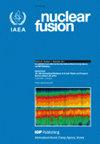使用新的开源二维反演分析代码估算 NSTX 和 DIII-D 上的分流器热负荷
IF 4
1区 物理与天体物理
Q1 PHYSICS, FLUIDS & PLASMAS
引用次数: 0
摘要
在基于 Python 的开源计算机代码 HYPERION 中开发了一种热成像反演算法,用于计算轴对称托卡马克中面向等离子体部件(PFC)的热通量。所选的表面网格尺寸会对瞬态热通量的计算结果产生重大影响。当网格尺寸趋近于零时,计算出的瞬态热通量将超过实际值,但当网格尺寸较大时,计算出的瞬态热通量将低于实际值。本文将讨论如何为瞬态热通量计算确定合适的网格尺寸。HYPERION 的数值方案采用二维全隐式有限差分方法,允许 PFC 材料的热特性随温度变化。反演算法分别以 NSTX 和 DIII-D 的热成像数据为基础,与 TACO 和 THEODOR 等成熟的热通量计算代码进行了比较。与 TACO 和 THEODOR 相比,HYPERION 的主要优势在于它是开源的,而且可以优化沿基体的网格厚度。该算法还考虑到了 PFC 因等离子体与材料相互作用而形成的薄表面层的热特性。HYPERION 和 THEODOR 之间的一致性非常好,在中高热通量的 DIII-D 数据情况下,代码之间的百分比差异平均为 ∼5%。使用 TACO 进行的验证测试表明,平均百分比差异略高,分别为 8%和 12%。在使用HYPERION研究热通量中的细丝时,初步结果表明,小的ELM细丝明显扩大了分流器的热通量,并降低了分流器的峰值通量。与间歇式 ELM 相比,小 ELM 丝降低了岔流器的峰值表面温度。在间歇式分流器灯丝的作用下,分流器热通量宽度与 L 模式下的相当。本文章由计算机程序翻译,如有差异,请以英文原文为准。
Divertor heat load estimates on NSTX and DIII-D using new and open-source 2D inversion analysis code
A thermography inversion algorithm has been developed in the open-source Python-based computer code, HYPERION, to calculate the heat flux incident on plasma-facing components (PFCs) in axisymmetric tokamaks. The chosen mesh size at the surface significantly affects the calculated transient heat flux results. The calculated transient heat flux will exceed the real value when the mesh size tends to zero but will underestimate the real value when the mesh size is large. A criterion for determining the appropriate mesh size for the transient heat flux calculation will be discussed. The numerical scheme for HYPERION uses a 2D fully implicit finite-difference approach, allowing temperature-dependent thermal properties of PFC materials. The inversion algorithm is benchmarked against established heat flux calculation codes, TACO and THEODOR, based on thermography data from NSTX and DIII-D respectively. The primary benefits of HYPERION compared to TACO and THEODOR are that it is open-source and it allows for the optimization of mesh thickness along the substrate. The algorithm also accounts for the thermal properties of thin surface layers that characteristically form on PFCs due to plasma-material interactions. The agreement between HYPERION and THEODOR is excellent, as the percent difference between the codes is ∼5% on average in the case of the DIII-D data for moderate to high heat flux. Verification tests with TACO show slightly higher average percent differences of 8% and 12%. In using HYPERION to study filaments in heat flux, the initial results indicate that small ELMs filaments significantly broaden the divertor heat flux, and decrease divertor peak flux. Compared to the inter-ELM, the small ELM filaments decrease the divertor peak surface temperature. With intermittent divertor filaments, the divertor heat flux width is comparable with that found in L-mode.
求助全文
通过发布文献求助,成功后即可免费获取论文全文。
去求助
来源期刊

Nuclear Fusion
物理-物理:核物理
CiteScore
6.30
自引率
39.40%
发文量
411
审稿时长
2.6 months
期刊介绍:
Nuclear Fusion publishes articles making significant advances to the field of controlled thermonuclear fusion. The journal scope includes:
-the production, heating and confinement of high temperature plasmas;
-the physical properties of such plasmas;
-the experimental or theoretical methods of exploring or explaining them;
-fusion reactor physics;
-reactor concepts; and
-fusion technologies.
The journal has a dedicated Associate Editor for inertial confinement fusion.
 求助内容:
求助内容: 应助结果提醒方式:
应助结果提醒方式:


